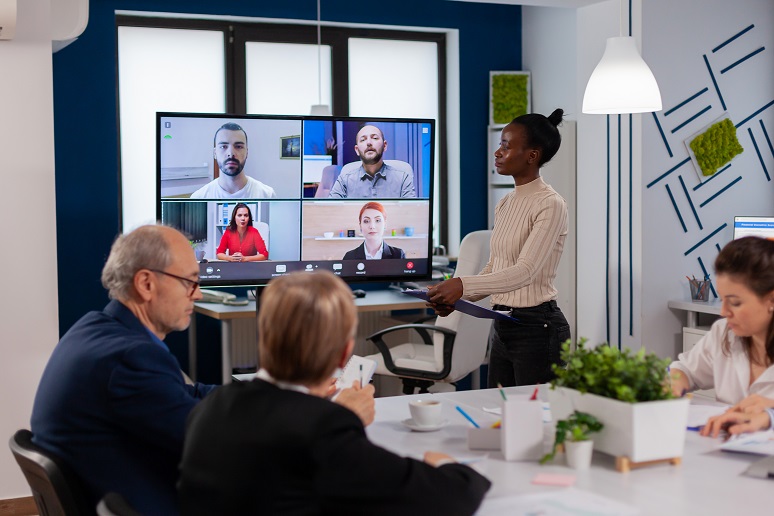With many companies bringing, or considering bringing, employees back to the office in some fashion over the next few months, a key challenge has emerged: how to ensure that meeting participants are able to engage equally whether they’re attending in person or remotely.
The old meeting arrangements in which most participants were physically in conference rooms, with only a handful of remote individuals joining via audio bridge, is no longer viable, especially when the math is likely to flip such that most participants continue to attend meetings remotely. Companies that have spent the last year and a half perfecting virtual meetings must avoid falling back into the trap of delivering different meeting experiences for those in-person versus those who are remote.
Achieving meeting equity requires a combination of both technology and human factors. On the technology front, those responsible for collaboration strategy and meeting room infrastructure should:
- Equip all rooms with high-quality audio and video capabilities to ensure that remote participants can easily engage with those who are in the rooms
- Consider physical changes to workspaces that bring people closer to cameras and avoid the “bowling alley” look of people around a long meeting room table
- Position cameras at eye level for a more natural engagement between in-office and remote employees
- Utilize virtual ideation and whiteboarding applications to avoid the temptation to return to dry erase whiteboard use. Virtual whiteboard apps enable remote participants to both contribute to, and follow, ideation generation that occurs during a meeting, and to build upon efforts made in each meeting
- Deploy touch screens in meeting spaces for ideation to better leverage virtual whiteboard apps
- Take advantage of polling capabilities increasingly available within meeting apps to obtain remote participant feedback
- Use meeting transcription and note-taking capabilities within meeting apps, or through third-party vendors, to ensure capture of highlights and action items, freeing participants up to better engage with one another during the meeting
- If appropriate, use real-time translation capabilities to enable closed captioning of audio in participant’s primary language
On the human side, consider:
- Investing in meeting facilitation training to help meeting leaders and participants better engage with all attendees, regardless of location and willingness to speak up during meetings
- Using approaches such as “study hall” time before a meeting so that participants can review meeting materials and come prepared to discuss and ask questions
- Evaluating if traditional one-hour meetings are really necessary, or if in-meeting tasks could be better accomplished through short, informal conversations or via chats in team collaboration applications
- Closing meetings with a period of attendee feedback (or use polling apps to accomplish this virtually), asking participants to share one rose (positive comment) and one thorn (comment on what could be done better next time)
Technologies for achieving meeting equity continue to improve as meeting vendors focus on eliminating the differences between in-person and remote participant. For example, AI-enabled meeting platforms and in-room hardware can capture individual participants in a meeting room and display them within their own boxes in the meeting, much as if they were participating remotely. Until such capabilities are commonly available, consider center-placement cameras or cameras that can track individual in-room participants as a means of displaying active speakers within a conference room.
Achieving meeting equity requires a proactive effort among business, facilities, HR, and IT to ensure sufficient investment in technologies to eliminate barriers between remote and in-office meeting participants, and to ensure sufficient training and culture that enables engagement, regardless of location. Now is the time to plan for return-to-the-office success by developing a plan for seamless meeting engagement.
Join us at Enterprise Connect 2021 to learn more about getting the most from video meetings. Register now using the promo code WSCAL200 for $200 off the current rate.







